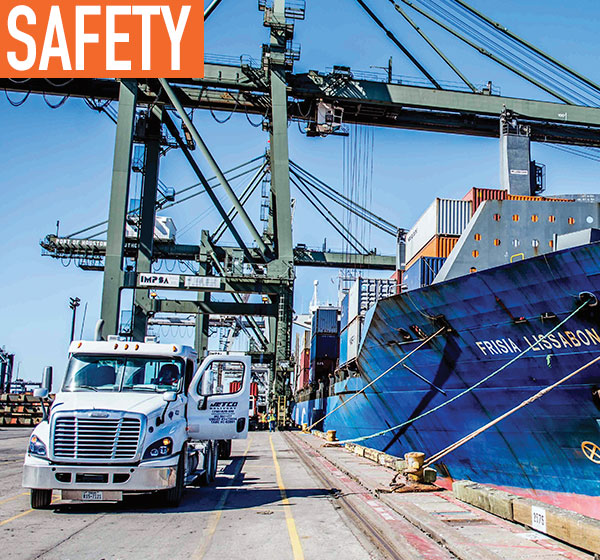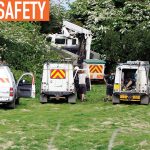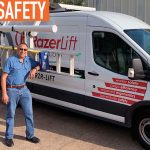Driving a heavy-duty truck remains one of the nation’s deadliest occupations. In 2017, 840 truckers lost their lives on the job, 6.6% more than the 786 reported by the US Bureau of Labor Statistics for 2016. The number of heavy-duty trucking deaths has risen by 25% since 2011.
There are several common causes of driver deaths: distracted driving, excessive speed, and lack of seat belt use. Deaths from each one are completely avoidable. The common thread is poor decision-making and behaviors. With that in mind, who can best prevent these tragedies—the individual, his/her employer, or the government?
It’s not the government. While laws and enforcement are critical deterrents, behavior is the key to safe outcomes. You can have all the laws you want, but at the end of the day safety is about making the right decision even when no one is looking. Speeding is a choice. The decision not to wear seat belts is a choice. The decision to drive while distracted is choice.
When it comes to responsibility for safe outcomes, both the company and the driver are in the best position to reduce deaths while behind the wheel. This boils down to creating a culture where accountability is a non-negotiable core value. If behavior is the key to safe outcomes, then accountability is the key ingredient to driving acceptable behaviors. Accountability is an overused and poorly defined term. We need to think about two distinct types of accountability—individual and organizational. If both types are woven into a company’s DNA, excellent safety outcomes are more likely.
INDIVIDUAL ACCOUNTABILITY
In a culture where individual accountability exists, employees govern themselves. They own their behaviors, which means putting the phone down, controlling their speed, and buckling up. When employees are accountable for safety, they are self-aware. The individual employee is always in the best position to prevent harm. Watch for signs that individual employees may lack the accountability to operate safely:
They pass the buck to another person; it’s never their fault.
They know the correct process but elect to circumvent it.
They do not fully understand how to perform a task but make no effort to seek clarification.
These individuals take shortcuts. The problem with shortcuts is that they work until tragedy strikes. The employees text and drive. Because they’ve not had an accident, they conclude that it is safe. It’s not safe. These employees are simply lucky, and their day of reckoning will come.
TEAM ACCOUNTABILITY
In a company where organizational accountability exists, people have an unconditional respect for process. Employees are well trained, and rule violations are strictly enforced. Accountable organizations are committed to continuous improvement. They realize that safety is a journey with no finish line. Where organizational accountability is lacking, the following will be evident:
The company accepts bad behavior and tolerates excuses. Over time, the employers learn who is operating recklessly, who is not using seat belts, and who is behaving badly. Yet they do nothing about it. They may look the other way, especially for “productive” or favored employees. In short, the company enables poor individual behavior.
Processes and expectations are not clear. Employees are not properly trained. There is no single set of best practices to follow. Absent a process-driven environment, employees are more likely to improvise, thus increasing the risk of making the wrong decision.

FEATURED IMAGE: A Jetco truck loading at Port Houston container terminal.
ABOVE: Act to End Distractions—National Safety Transportation Safety Board roundtable hosted in collaboration with Jetco Delivery.
Demands are not reasonable. There is an overt or tacit understanding that productivity trumps safety. A mentality exists to “do whatever it takes to get the job done,” even at the expense of safety. In this environment, drivers feel pushed into cutting corners (i.e. speeding), thus increasing the probability of a tragic outcome.
The employer thinks that safety is a “priority.” Safety is not a priority. It is a non-negotiable core value. Priorities change by the day. Values are immutable.
The employer views safety as a cost. Safety is an investment, not a cost. If you think safety is expensive, consider the cost of interrupted operations, poor employee morale, and reputation damage stemming from a poor safety culture.
DRIVER SHORTAGE
It has been asked whether these high death rates are causing talented drivers to leave the profession or playing a role in the industry’s difficulty recruiting new drivers. I don’t believe that the death rates in and of themselves are contributing to the driver shortage. The high death rates are symptoms of an underlying problem: poor behaviors and lack of accountability. To the extent that an individual lacks personal values to control his or her behavior behind the wheel, we want them out of the industry. It’s that simple.
Unsafe companies will not attract the best talent. Professional drivers have many career choices. Having a well-defined safety culture will attract excellent talent. These employees know that they are cared for. They know that the employer puts their heath above any load. In such a culture, the employees have the power to call safety related time-outs for any reason.
If individual and organizational accountability are tightly woven into a company’s DNA, safety failures are reduced. If safety is recognized as a non-negotiable core value, employees are empowered to make the right decisions. Employees and those around them return home safely each night. This happens by creating a non-negotiable culture of accountability where excellent behaviors are recognized and employees are weeded out if they are unable to correct their poor behaviors.
ABOUT THE AUTHOR
Brian Fielkow is the CEO of Jetco Delivery, Inc. Find out more, visit www.jetcodelivery.com.
MODERN WORKTRUCK SOLUTIONS:
OCTOBER 2019 ISSUE
Did you enjoy this article?
Subscribe to the FREE Digital Edition of Modern WorkTruck Solutions magazine.





